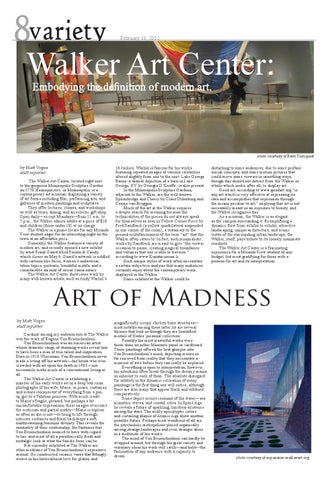8variety
February 10, 2012
Walker Art Center: Embodying the definition of modern art.
photo courtesy of Berit Turnquist
by Matt Voges staff reporter The Walker Art Center, located right next to the gorgeous Minneapolis Sculpture Garden on 1750 Hennepin Ave. in Minneapolis, is a contemporary art museum displaying a variety of art forms including film, performing arts, and galleries of modern paintings and sculptures. They offer lectures, classes, and workshops as well as tours, dining, and an eclectic gift shop. Open daily—except Mondays—from 11 a.m. to 5 p.m., the Walker admits adults at a price of $10 and children (those under 18) at no charge. The Walker is a prime locale for any Mounds View student eager for an interesting night on the town at an affordable price. Generally, the Walker features a variety of modern art, and recently opened a new exhibit by artist Frank Gaard titled Poison & Candy, which closes on May 6. Gaard’s artwork is riddled with cartoon-like faces, women’s underwear, taboo topics, portraits, bountiful motifs, and a considerable amount of social commentary. The Walker Art Center showcases work by many well-known artists, such as Andy Warhol’s
16 Jackies. Warhol is famous for his works featuring repeated images of various celebrities altered slightly from one to the next. Lake George Barns--a dismal depiction of a barn in Lake George, NY by Georgia O’Keeffe--is also present. In the Minneapolis Sculpture Gardens, adjacent to the Walker, are the well-known Spoonbridge and Cherry by Claes Oldenburg and Coosje van Bruggen. Much of the art at the Walker requires a deeper search for meaning because the technicalities of the pieces do not always speak for themselves as seen in Yellow Corner Piece by Fred Sandback (a yellow quadrilateral suspended in one corner of the room), a testament to the present multifariousness of the term “art” that the Walker often caters to. In fact, such minimalistic works by Sandback are meant to give “the viewer occasion to pause, creating magical boundaries and volumes that one is able to traverse.” according to www.Kunstmuseum.li. Such unique styles of work often necessitate a certain subjective analysis that many audiences certainly enjoy about the contemporary work displayed in the Walker. Some exhibits at the Walker could be
disturbing to some audiences, due to some profane sexual concepts, and some motion pictures that could move some viewers in unsettling ways, though this should not detract from the Walker as whole which seeks, after all, to display art. Good art, according to www.goodart.org “is any art which is very effective at expressing its idea and accomplishes that expression through the means peculiar to art,” implying that art is not necessarily meant as an exposure to beauty, and the Walker recognizes this. As a museum, the Walker is as elegant as the campus surrounding it. Exemplifying a dynamic flow from exhibit to exhibit, attractive landscaping, unique architecture, and scenic vistas of the surrounding urban landscape, the Walker, itself, pays tribute to its loosely inanimate residents. The Walker Art Center is a fascinating experience for a Mounds View student of any budget, but most gratifying for those with a passion for art and its interpretation.
Art of Madness
by Matt Voges staff reporter Cardinal among my endearments at The Walker was the work of Eugene Von Bruenchenhein. Von Bruenchenhein was an American artist whose dramatic range of stunning works reveal him to have been a man of true talent and inspiration. Born in 1910 Wisconsin, Von Bruenchenhein never made a living off his artwork—his house was overcrowded with art upon his death in 1983—nor necessarily made much of a conventional living at all. The Walker Art Center is exhibiting a number of his early works set in a deep teal room: photographs of his wife, Marie, in poses, costumes, and scenes reminiscent of everything from a pinup girl to a Tahitian princess. With much credit to Marie’s fragile, pleased, but perhaps a bit uncomfortable expressions, these images overcome the eroticism and partial nudity—Marie is topless as often as she is not—to bring to life through intricate costumes and floral backdrops a soft, nonthreatening feminine divinity. This reveals the sensuality of their relationship, the fantasies that Von Bruenchenhein seemed to have with regard to her, and most of all a paradoxically fresh and nostalgic look at what the female form can be. Not currently exhibited at The Walker are other mediums of Von Bruenchenhein’s expressive arsenal. He constructed ceramic vases that fittingly weave in his horticulturist love for plants, and
magnificently creepy chicken bone structures— most notable among these latter lot are several thrones that look as though they are beautified models of Hades’ personal collection. Possibly his most masterful works were those done on either Masonite panel or cardboard. These paintings offered the best glimpse into Von Bruenchenhein’s mind, depicting scenes so far removed from reality that they necessitate a moment of awe before they can really be explored. Everything is open to interpretation; however his intentions often break through the dreamy mania so inherent to each of them. The absolute disregard for subtlety in the dynamic coloration of many paintings is the first thing one will notice, although there are also many that appear black and subdued comparatively. Some depict scenes resonant of the water—sea monsters, waves, and coastal cities. In Space Age, he reveals a future of sparkling, limitless existence among the stars. The sickly apocalyptic colors and curtailing shapes of Atomic Age show another possible future. Perhaps most wondrous of all are the psychedelic metropolises placed organically among strange landscapes and even stranger skies in a multitude of his works. The mind of Von Bruenchenhein can hardly be wrapped around, but through his great variety and visionary ideas his work will catch—and hold—the fascination of any audience with a capacity to dream.
photo courtesy of expansion.walkerart.org
